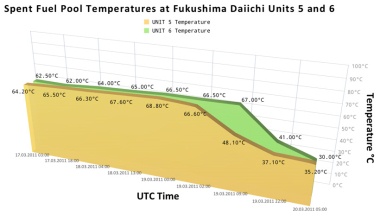FIRST PUBLISHED 2.05pm GMT
UPDATE 1: 2.56pm GMT Units 5 and 6 in cold shutdown, tsunami heights
UPDATE 2: 3.30pm GMT IAEA graph of fuel pond temperatures
Workers on site have succeeded in increasing the stability of the Fukushima Daiichi reactors, with units 5 and 6 now in cold shutdown. Pressure built up within unit 3 but a more significant venting does not seem necessary now.
External power has now been connected to unit 5 and 6, allowing them to use their residual heat removal systems and transfer heat to the sea. This has been used to cool the fuel ponds and bring the units to cold shutdown status, meaning that water in the reactor system is at less than 100ºC.
 |
| This graph from the International Atomic Energy Agency illustrates how fuel pond temperatures have dropped at units 5 and 6 since the connection of external power and use of the residual heat removal system was restarted |
An extended operation to refill the fuel pond took place at unit 3, with the Hyper Rescue crew spraying for over 13 hours. Radiation levels 500 metres north of the reactor showed a decrease from 3.44 millisieverts per hour to 2.75 millisieverts per hour, indicating a measure of success in refilling the pond. A similar operation is planned for later today at unit 4 and the surface temperatures of the buildings appear to be below 100ºC.
At units 1 and 2, external power has been restored. Tokyo Electric Power Company (Tepco) said it would restore functions in the central control room shared by the units so that accurate readings could again be taken from the reactor system. Next, workers will check the condition of the water supply systems to the reactor and the used fuel pond. With luck these will be able to go back into operation as they had been immediately after the earthquake on 11 March.
External power for units 3 and 4 should be in place 'in a few days' time', said Tepco.
Tsunami data
Tepco has now released tentative assessments of the scale of the tsunami putting it at over 10 metres at Daiichi and over 12 metres at Dainii. |
During the day, the company had noted a pressure increase within unit 3, warning that venting may be required. Preparations were underway to open the relief vale on the torus suppression chamber, or if that had proven full of water, another valve on the reactor containment. These operations had been expected to release a more significant amount of radioactivity than earlier venting, but Tepco has since said the higher pressure is stable and it does not need to vent.
Radiation monitors in the area near the plant have shown gradually decreasing readings since spikes on 15 March following the loud noises and apparent rupture of the torus of unit 2. While levels were above natural background radiation they have not posed a threat to public health. Most people within 20 kilometres were evacuated before that time and people in a further ten-kilometre radius has been warned to stay indoors. Evacuation centres have been supplied with potassium iodide tablets that would protect people's thyroid glands in the case of a serious release of radionuclides from the reactor cores.
Despite contradictory comments by the US Nuclear Regulatory Commission to US politicians and media, most observers in nuclear industry and regulation consider the measures taken by Japanese authorities to be prudent and appropriate.
Researched and written
by World Nuclear News





_18570.jpg)
_16159.jpg)
_49205.jpg)





